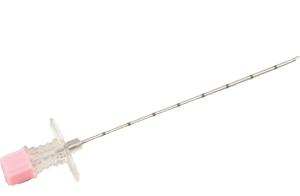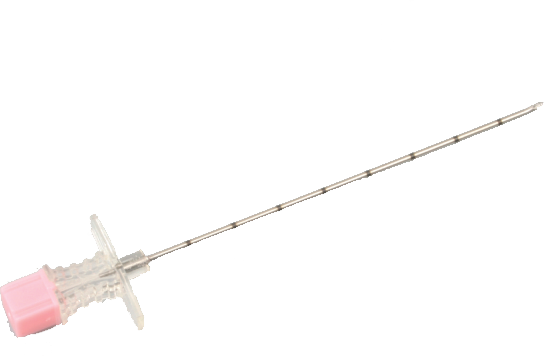Disposable Epidural Needle
Disposable Epidural Needle
You may have heard about Disposable Epidural Needles and are wondering what they are. These single use needles are made for a single epidural procedure or for a single injection. It's important to know that Epidural needles are disposable and need to be replaced after one use in order to maintain the safety of health care providers and patients.
Description
- Bend and round head helps to reduce largely the risk of piercing spinal dura mater and ensure the smooth pass of the canula.
- The needle tube is scaled for the purpose of depth control.
- The needle stand with wings is easy to hold and to perform needle insertion.
What are Disposable Epidural Needles?
Disposable epidural needles are used during epidural anesthesia, a type of regional anesthesia. Epidural anesthesia numbs the nerves in a specific area of your body. It's typically used during childbirth, surgery, and certain types of pain management. Disposable epidural needles are made of stainless steel and have a hollow center. They're inserted into the epidural space, which is the area between the dura mater (the outermost layer of the meninges) and the vertebrae. Once the needle is in place, a catheter (a thin tube) is threaded through it and into the epidural space. The advantage of using disposable needles is that they're sterile and can be used only once. This reduces the risk of infection and cross-contamination. Disposable needles are also more convenient than reusable needles because they don't require special cleaning or storage before or after use.
Why are they used in medical procedures?
There are many reasons why disposable epidural needles are used in medical procedures. One reason is that they help to prevent the spread of infection. Another reason is that they are less likely to cause tissue damage. Disposable needles are also easier to handle and less likely to break during use.
How are Disposable Epidural Needles used?
There are a few different ways that disposable epidural needles can be used. The most common way is to insert the needle into the epidural space, which is the space around the spinal cord. This allows the needle to be in direct contact with the spinal cord, which is where the pain signals are sent. Another way that disposable epidural needles can be used is to insert them into the dura mater. The dura mater is a tough, outer layer of tissue that surrounds the spinal cord. Inserting the needle into this space can help to block pain signals from getting to the brain. Finally, disposable epidural needles can also be used to inject medication directly into the spinal cord. This can help to provide pain relief by numbing the area around the injection site.
Are there any risks associated with Epidural Procedures or the use of disposable epidural needles?
There are very few risks associated with epidural procedures or the use of disposable epidural needles. The most common risk is a small puncture wound at the site where the needle was inserted. This usually heals quickly and does not cause any long-term problems. In rare cases, the needle may damage a blood vessel or nerves near the spine, which can lead to serious complications.
Disposable Epidural Needle are administered to patients suffering from back inflammation and/or pain. The medicine is delivered directly into the epidural space, the area surrounding the spinal cord and nerves. Epidural injections contain corticosteroid in them. Corticosteroid mimics the hormone cortisone and hydrocortisone, which reduces inflammation of the affected nerves, relieving pain albeit temporary. As with all medicine, it carries certain risks with it and although rare, is still a possibility.
Risks
Infection
As epidural injections are an invasive procedure, infections can occur at the injection site if the needles are unclean. However, this only occurs to 0.01% of all injections as needles are disposable and sterile nowadays.
Dural puncture
An unintentional dural puncture can occur when the needle accidentally passes through the dura mater and into the cerebrospinal fluid. Patients will usually experience a post dural puncture headache which is normally delayed for between 24 to 48 hours and will typically last for 3 to 4 days. Anaesthetistswill do a simple epidural blood patching by clotting the spinal sac and stopping the leak to treat severe cases of dural puncture.
Reactions
Depending on individual, some may experience allergy reactions due to the corticosteroid as their body is defending against these foreign intruducer.
Side effects
Apart from risks, side effects of the corticosteroid may also be experienced by patients. Common side effects include:
1. Increase in pain at the injection site may be experienced by patients most commonly due to skin tissue irritation.
2. Flushing of the skin due to their body reacting with the steroid.
3. Patients may experience itchiness as their body's defense mechanism is reacting with the steroid.
4. Patients may sometimes develop fever due to infection at the injection site.
5. Loss of sleep may occur to some as patients feel discomfort.
Epidural steroid injections are generally safe and are effective to relieve back pain. It is ideal for patients who do not wish to undergo surgery yet requires a long term solution to it. It is ideal for most patients except those with bleeding disorder. However, patients can only undergo the most 3 injections within a six months timeframe as the medication in each injection lasts more than 6 months.
We introduce you Nexgenmedical where professional help will be offered in the areas of diagnosis, treatment and rehabilitation for Disposable Epidural Needle and sports injuries.
At
Nexgenmedical you will get all types of
Healthcareproduct at lowest price.

